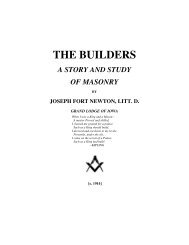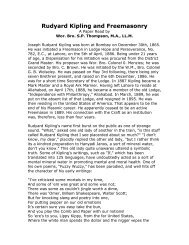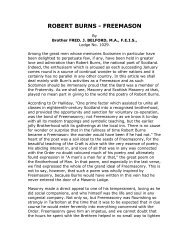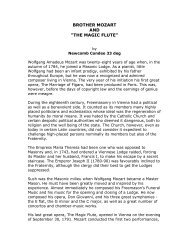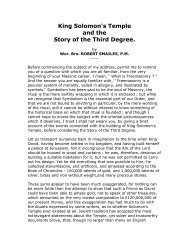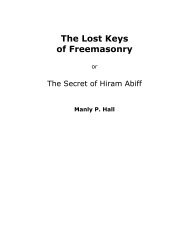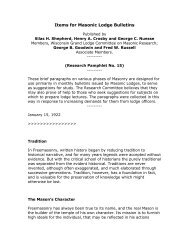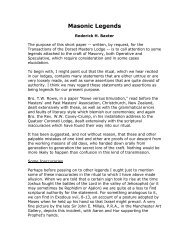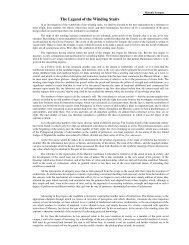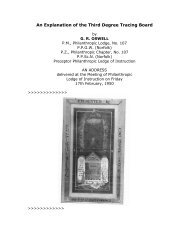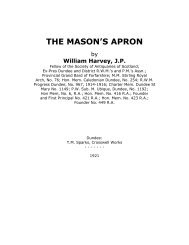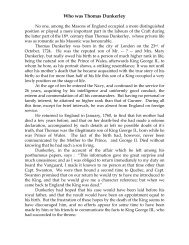Through the Key Hole - RoseCroix.org.au
Through the Key Hole - RoseCroix.org.au
Through the Key Hole - RoseCroix.org.au
Create successful ePaper yourself
Turn your PDF publications into a flip-book with our unique Google optimized e-Paper software.
56<br />
120<br />
There are of course many o<strong>the</strong>r possibilities and probabilities arising<br />
from his activities throughout his life which will have influenced his<br />
thinking concerning <strong>the</strong> Craft, such as, for example, <strong>the</strong> question of<br />
negro members and <strong>the</strong> general Masonic policy in regard <strong>the</strong>reto, but<br />
whatever <strong>the</strong> reason, history reflects that Lincoln did not become a<br />
Freemason.<br />
Certainly his exposure to <strong>the</strong> Craft and its members, his close connection<br />
with <strong>the</strong> activities of Freemasons, his own character which<br />
was fundamentally Masonic in nature, are all factors that indicate he<br />
would have become a Freemason had he not been assassinated.<br />
Or would he?<br />
COLOURFUL FREEMASONRY<br />
By. Wor. Bro. F Hookham<br />
You may have heard mention of “Blue” and “Red” Lodges, but how<br />
about <strong>the</strong> colours white and black?<br />
The term “Blue” is used in many countries of <strong>the</strong> world, especially on<br />
<strong>the</strong> continent of Europe and in <strong>the</strong> America’s for <strong>the</strong> “craft”. “Red”<br />
masonry is <strong>the</strong> Royal Arch, “Black” Masonry refers to <strong>the</strong> Prince<br />
Hall Lodges whose origin dates to <strong>the</strong> African Lodge No. 459 warranted<br />
by <strong>the</strong> Grand Lodge of England on 29 September 1784. This<br />
lodge was removed from <strong>the</strong> list of lodges for non-payment of dues<br />
at <strong>the</strong> time of union of <strong>the</strong> two Grand Lodges that existed in England<br />
in 1813. “White” Masonry refers to <strong>the</strong> upper section of <strong>the</strong> “York” or<br />
“American” Rite of which <strong>the</strong> principal section is <strong>the</strong> Masonic Knight<br />
Templars whose basic regalia is white in colour.<br />
Blue Masonry is a term used in <strong>the</strong> USA since <strong>the</strong> 18th Century and<br />
on <strong>the</strong> continent of Europe to denote <strong>the</strong> three craft degrees. Blue<br />
has always been highly esteemed as a symbolic colour. The Egyptians<br />
represented <strong>the</strong>ir principal god “Amun” as coloured blue.<br />
Jeremiah 10 verse 9 states that <strong>the</strong> Babylonians coloured <strong>the</strong>ir idols<br />
blue as <strong>the</strong> appropriate colour for <strong>the</strong> gods.<br />
The medieval Christians regarded blue as <strong>the</strong> symbol of immortality,<br />
perfection, hope and fidelity. Exodus 28 verse 31 states “Thou shalt<br />
make <strong>the</strong> robe of <strong>the</strong> ephod all of blue”. The people were directed to<br />
wear blue ribbon above <strong>the</strong> fringe of <strong>the</strong>ir garments<br />
There is no actual record of <strong>the</strong> adoption of blue as <strong>the</strong> characteristic<br />
colour of Craft Masonry, but it may well be by simple analogy with<br />
<strong>the</strong> blue v<strong>au</strong>lt or come of heaven. In one of <strong>the</strong> exposures of <strong>the</strong><br />
question and answer type published in 1730:<br />
Q. “ How as he clo<strong>the</strong>d?” (referring to <strong>the</strong> Wor. Master).<br />
“In a yellow jacket and a blue pair of breeches” .



